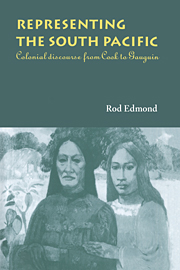Book contents
- Frontmatter
- Contents
- List of illustrations
- Acknowledgements
- 1 Introduction
- 2 Killing the god: the afterlife of Cook's death
- 3 Mutineers and beachcombers
- 4 Missionary endeavours
- 5 Trade and adventure
- 6 Taking up with kanakas: Robert Louis Stevenson and the Pacific
- 7 Skin and bones: Jack London's diseased Pacific
- 8 The French Pacific
- 9 Epilogue
- Notes
- Index
4 - Missionary endeavours
Published online by Cambridge University Press: 31 October 2009
- Frontmatter
- Contents
- List of illustrations
- Acknowledgements
- 1 Introduction
- 2 Killing the god: the afterlife of Cook's death
- 3 Mutineers and beachcombers
- 4 Missionary endeavours
- 5 Trade and adventure
- 6 Taking up with kanakas: Robert Louis Stevenson and the Pacific
- 7 Skin and bones: Jack London's diseased Pacific
- 8 The French Pacific
- 9 Epilogue
- Notes
- Index
Summary
The founders of the London Missionary Society (LMS), set up in 1795, had read Cook, spoken with Bligh, and decided that Tahiti was the most promising part of ‘the heathen world’ for a mission. The only anticipated difficulties were ‘such as may arise from the fascination of beauty, and the seduction of appetite’.Two years later eighteen missionaries, ‘Godly men who understood mechanic arts’, landed on Tahiti. Very few were ordained ministers; most were artisans – carpenters, bricklayers, weavers, tailors and the like. Gunson describes this group of ‘godly mechanics’ as an artificial class separated from their fellow-artisans and home culture by their dogmatic beliefs and strict way of life. They brought with them, therefore, a particularly rigid version of their own culture which they tried to impose on their native hosts. Many had undergone some kind of conversion experience, and their missionary impulse was fed by a desire to reproduce this experience in the lives of others. The urge to convert also clearly involved a projection of their own deep sense of original depravity on to the heathen islanders. Nevertheless, the earliest missionaries landed on Tahiti in a spirit of optimism and brotherhood. The South Pacific was seen as a distinct kind of field marked out by its hospitality and imputed receptivity to the Christian message. Those who had chosen and instructed the first missionaries relied on secular accounts of the region, and the newly arrived missionaries were to complain that they had been misled about what to expect.
- Type
- Chapter
- Information
- Representing the South PacificColonial Discourse from Cook to Gauguin, pp. 98 - 129Publisher: Cambridge University PressPrint publication year: 1997

